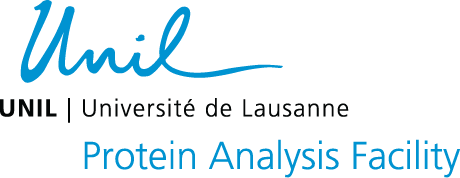Guidelines
The following guidelines have been written based on our experience in the last few years of operation. They are inspired by similar guidelines applied by other core facilities and are in agreement with the UNIL-CHUV Core facilities guidelines regarding scientific publications, collaborations and fees.
Services and fees
The mission of the Protein Analysis Facility (PAF) of the University of Lausanne is to support the local research community in the analysis of proteins and proteomes. To help support its activity and equipment purchases, the facility operates with fees, which apply to a well defined list of analyses. Such fees are differentiated depending of the affiliation of the user(s).
We do not have dedicated funding for carrying out collaborative projects. Therefore, in principle all PAF users have to arrange payment of their analyses according to the fees and categories mentioned above. Exceptions are listed below.
We strongly encourage investigators to request specific funding for proteomics at the time of grant application. The facility coordinator can provide support and suggestions for the writing of research proposals and can of course prepare letters of support and confirmation.
Publications
For manuscript writing, the PAF will, upon request, provide the users with i) descriptions of materials and methods relevant to the experiments performed ii) comprehensive supplementary tables in a format accepted by most journals (.txt, .pdf or .xls) and iii) raw data. Unless agreed differently (see below) the PAF will not prepare publication-style tables and figures to be included in the main article body nor write portions of article text. We will also try to support users as much as possible in the process of raw data deposition to public databases such as proteomexchange.org.
Acknowledgements
As a minimum, the work carried out by the PAF should be acknowledged in all publications which either present data directly produced by the facility or results for the generation of which the work of the PAF played an important role. The name and affiliation of the facility should be fully and correctly mentioned as follows :
“Protein Analysis Facility, Center for Integrative Genomics, Faculty of Biology and Medecine, University of Lausanne, Switzerland”.
No specific person names need to be listed, unless desired by the authors.
Authorship
In general we apply the guidelines established by the International Committee of Medical Journal Editors and similar organizations as discussed by Huth, 1986 and Bailey, 2001.
In essence, if scientists from the PAF have significantly helped to design or conceive the experiments, have done non-standard analysis and interpretation of data, or both, they should be coauthors of papers that include data generated by the facility. In this case PAF scientists should participate in drafting the paper or revising it for critically important content, and give final approval of the version to be published. If these conditions are not met, the PAF should appear only in the acknowledgements (see above). In case of uncertainty about authorship, the investigator should clarify these issues with the facility coordinator, preferably before start of the experiments.
Collaborations
We define two types of collaborations :
1) User-initiated collaborations are those in which the proponent is a PAF user. The PAF coordinator, in agreement with his Steering Committee, can accept to carry out collaborative projects with the goal to push the limits of analysis on a set of challenging samples. Such projects are in principle subject to the same fees as routine work. However, the PAF will engage in a closer collaboration with the user to provide optimized support and improve aspects such as experimental design, sample preparation and data analysis. Also, the PAF team can decide to use the samples from the project to implement and test new technologies. In such case, some analyses can be free of charge. For this type of collaborations, the PAF members involved should be co-authors of resulting publications. The details of the collaboration and co-authorship (position, etc) should be discussed at the beginning of the project.
2) PAF-initiated collaborations : the PAF can contact biomedical investigators to propose collaborations. One of the primary purposes is to acquire challenging biological samples for the implementation, test or development of new techniques. Such analyses are generally free of charge for the user. The PAF coordinator has to ensure that the resulting workload is compatible with the capacity and normal operation of the core and does not lead to a significant increase in the waiting times for other regular users. For this type of collaborations the PAF members involved will be co-authoring the resulting publications together with the lab providing the samples. The details of co-authorship should be discussed at the beginning of the project.
